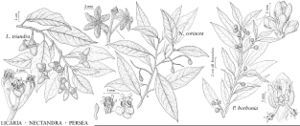Difference between revisions of "Persea borbonia"
Syst. Veg. 2: 268. 1825.
Common names: Red bay
EndemicSelected by author to be illustrated
Basionym: Laurus borbonia Linnaeus
Synonyms: Persea littoralis Small Tamala borbonia (Linnaeus) Rafinesque Tamala littoralis (Small) Small
Treatment appears in FNA Volume 3.
FNA>Volume Importer |
FNA>Volume Importer |
||
| Line 16: | Line 16: | ||
}} | }} | ||
|basionyms={{Treatment/ID/Synonym | |basionyms={{Treatment/ID/Synonym | ||
| − | |name= | + | |name=Laurus borbonia |
|authority=Linnaeus | |authority=Linnaeus | ||
}} | }} | ||
|synonyms={{Treatment/ID/Synonym | |synonyms={{Treatment/ID/Synonym | ||
| − | |name= | + | |name=Persea littoralis |
|authority=Small | |authority=Small | ||
| − | }}{{Treatment/ID/Synonym | + | }} {{Treatment/ID/Synonym |
| − | |name= | + | |name=Tamala borbonia |
|authority=(Linnaeus) Rafinesque | |authority=(Linnaeus) Rafinesque | ||
| − | }}{{Treatment/ID/Synonym | + | }} {{Treatment/ID/Synonym |
| − | |name= | + | |name=Tamala littoralis |
|authority=(Small) Small | |authority=(Small) Small | ||
}} | }} | ||
| Line 43: | Line 43: | ||
|elevation=0-100 m | |elevation=0-100 m | ||
|distribution=Ala.;Ark.;Fla.;Ga.;La.;Miss.;N.C.;S.C.;Tex. | |distribution=Ala.;Ark.;Fla.;Ga.;La.;Miss.;N.C.;S.C.;Tex. | ||
| − | |discussion=<p>Some Native Americans used Persea borbonia for medicinal purposes (D. E. Moerman 1986).</p> | + | |discussion=<p>Some Native Americans used <i>Persea borbonia</i> for medicinal purposes (D. E. Moerman 1986).</p> |
|tables= | |tables= | ||
|references= | |references= | ||
| Line 56: | Line 56: | ||
|rank=species | |rank=species | ||
|parent rank=genus | |parent rank=genus | ||
| − | |synonyms= | + | |synonyms=Persea littoralis;Tamala borbonia;Tamala littoralis |
| − | |basionyms= | + | |basionyms=Laurus borbonia |
|family=Lauraceae | |family=Lauraceae | ||
|phenology=Flowering spring–early summer. | |phenology=Flowering spring–early summer. | ||
| Line 67: | Line 67: | ||
|publication year=1825 | |publication year=1825 | ||
|special status=Endemic;Selected by author to be illustrated | |special status=Endemic;Selected by author to be illustrated | ||
| − | |source xml=https://jpend@bitbucket.org/aafc-mbb/fna-data-curation.git/src/ | + | |source xml=https://jpend@bitbucket.org/aafc-mbb/fna-data-curation.git/src/8f726806613d60c220dc4493de13607dd3150896/coarse_grained_fna_xml/V3/V3_912.xml |
|genus=Persea | |genus=Persea | ||
|species=Persea borbonia | |species=Persea borbonia | ||
Revision as of 17:20, 18 September 2019
Trees, to 25 m. Branches appressed-pubescent. Leaf blade narrowly elliptic to widely ovate, 6-16 × 2-5 cm; surfaces abaxially pale, glaucous, moderately pubescent when young with rusty brown, appressed hairs, glabrescent with age, adaxially green, lustrous. Inflorescences: peduncle equal to or shorter than subtending leaf petiole, pubescent. Drupe (8-)10 mm diam., usually glaucous. 2n = 24.
Phenology: Flowering spring–early summer.
Habitat: In hammocks, mixed hardwoods, coastal dunes, maritime forests, outer Atlantic and Gulf coastal plains, rarely in the Piedmont
Elevation: 0-100 m
Distribution

Ala., Ark., Fla., Ga., La., Miss., N.C., S.C., Tex.
Discussion
Some Native Americans used Persea borbonia for medicinal purposes (D. E. Moerman 1986).
Selected References
None.
Lower Taxa
None.
